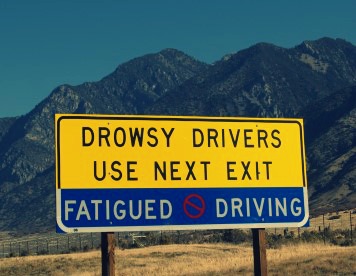 STEVE MUELLER
STEVE MUELLER
Relationship Manager
In honor of National Truck Driver Appreciation Week (Sept. 14-20), we're covering all-things trucking on the blog. Stay tuned for transportation content all week!
As the leader of a trucking firm, you know accidents caused by fatigued driving are all-too common in the transportation industry. Driving a truck is a physically and mentally demanding job. That's why (regardless of how you feel about the regs) the Hours of Service exist.
Sitting for long periods of time while staring at the road ahead can be mesmerizing and easily lull a person to sleep. Combine that with being wiped out from work with cargo, truck maintenance, etc... well, you know what can happen.
Luckily, there are many ways to fight fatigued driving. Here are four ways your drivers can keep themselves — and those with whom they share the road — safe from potentially devastating consequences of fatigued driving:
1.) Get Some Shut-Eye
This seems obvious, but when a driver feels drowsy and is worried that he may fall asleep, it’s time to pull over and take a quick break or a cat nap. We get it — it's not easy to make this decision, considering efficiency and time restraints on hauls. But if a driver is feeling too tired to drive, a snooze could save a life (maybe even his own!). It's important to help your drivers identify when they're pushed themselves too far.
2.) Sip Coffee
This is an old chestnut to share with drivers! Now, too much caffeine can have very negative side effects: insomnia, restlessness, and irritability. But consciously having a couple cups of coffee is OK when trying to keep yourself awake during a long drive. Remember: Everything in moderation.
3.) Be a Healthy Trucker
This includes eating at normal times throughout the day. Encourage drivers to consume a health amount (i.e., don't binge) during meals, and at each meal, they should eat a healthy balance of protein, carbs, and fruits and veggies (eat fats/sweets sparingly). Help your talent find time to exercise on off days and during breaks. A truck needs the right fuel and maintenance, and so does the human body! A healthy combo of food and exercise will keep drivers energized, awake, and making safe decisions for your company.
4.) Avoid the NyQuil Bandwagon
Taking medication that makes a driver drowsy only will promote the need for sleep when on the road. Encourage your drivers to stay away from sleep medications when possible. Improving your overall health and pulling back when your body says it's too tired to drive are the safest and smartest options for you and your drivers.
What's Next in the Fight Against Fatigued Driving
A researcher at Wichita State University has adapted Google Glass with eye-tracking technology. The smart glasses measure blinking and indicators of drowsiness. The data then is transferred to an app that tells the user when he's dangerously sleepy. (Just a heads up — Google Glass is illegal in some states while driving, so be aware of the rules in the places where you operate.)
The smart glasses technology from Wichita State isn't yet widely available, but there's a similar product called Optalert that boasts an early warning system to catch sleepiness. We predict there's lots more to come with biometric technology.
Safety is a perennial issue in the transportation industry, and accidents caused by fatigued driving show up too often for the likes of trucking firms and their hard-working drivers. The smartest thing your organization can do to mitigate this risk is encourage your fleet to become healthy truckers. The tragic alternative is becoming the next news story about fatigued driving!
Related Posts:
Wellness Program Incentive Ideas You Can Count On
Demonstrating Wellness Program ROI
5 Driver Wellness Program Ideas That Actually Work
Keep It In the Family: Including Spouses & Kids in Wellness Programs
.png?width=69&height=53&name=Acrisure%20Logo%20(White%20Horizontal).png)


